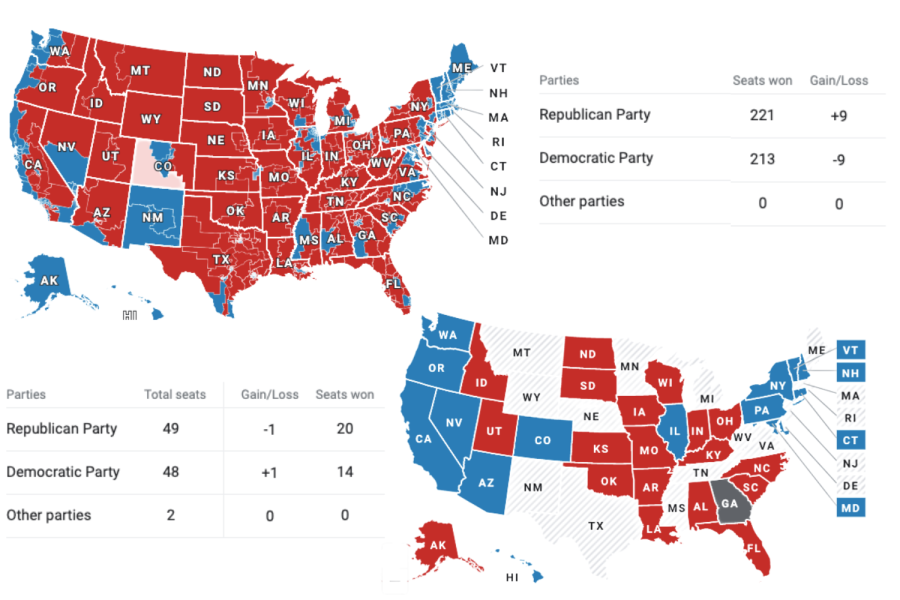US holds midterm elections, Congress enters lame duck period
(Photo Credit: Isabel Bequer/AchonaOnline/Canva)
The 2022 midterms left changes in the makeup of the House and Senate and left Congress divide between Republican and Democrat control.
On November 8, the United States held its final day of voting for the 2022 midterm elections. In the election, 35 Senate seats, and all 435 House of Representatives seats were up for election. On the state level, 36 gubernatorial positions were open. While the majority party has been decided in each house, one Senate seat remains unfulfilled, as the Georgia race resulted in a run-off. Additionally, these new members will not take their seats until January, giving current members time for last-ditch efforts at passing legislation.
“I’m happy with some results from the election but I feel like more people still need to get out and vote. I think certain people didn’t vote because they didn’t like the options but it’s better to have a somewhat good person in charge than a bad person,” said Nora Kelly (‘25).
Prior to the election, many anticipated a “red wave,” with several seats being flipped for Republicans. This would be in line with previous midterm elections, since Biden’s approval rating was relatively low and Democrats had control of both houses of Congress. Midterms often act as a referendum on the president, so when the presidential approval rating is low, there is often a shift towards the opposing party. However, Democrats overperformed in several states, and managed to win key races to keep the parties more evenly matched.
The performances from both parties could be linked to the issues they chose to emphasize leading up to the election. Republicans placed focus on the economy and high inflation rates, often placing blame on Democrats for the poor state of the economy and its effect on consumers. Democrats, on the other hand, emphasized access to abortion, a hot-button topic following the Supreme Court’s decision in the Dobbs v. Jackson earlier this year, which overturned the precedent set in Roe v. Wade and left laws surrounding abortion entirely to the states. This may have resonated more strongly with voters and led to the Democrats’ strong performance, since according to the Pew Research Center, over 57% of Americans were opposed to the case being overturned.
The midterms also saw attention as it was the first national election since former president Donald Trump left office. The 2020 election saw many swing states vote for Democrats. Suburban areas, which tend to swing either direction, were also key for Democrats in 2020. Pre-election speculation wondered if these areas would remain blue, or go back to being more moderate or conservative. While they were not overwhelmingly left-leaning, Democrats did manage to hold their own in these areas — a key part of stopping the predicted “red wave.”
A few days before the midterm election, Politico ran a piece saying young voters are “MIA.” We proved them wrong by turning out in huge numbers — preventing a red wave. And young voters in Georgia will show up again & help re-elect Raphael Warnock. Just wait & see.
— Victor Shi (@Victorshi2020) November 26, 2022
There was also a question about Trump’s remaining influence in the Republican party. Trump endorsed several candidates across state and national levels of government. However, these endorsements may not have held as much weight as expected, as many Trump-endorsed candidates involved in more competitive races lost. Additionally, candidates that denied the results of the 2020 election, perpetuating the idea that Trump actually won, lost their races. This may reflect a diminishing authority within the party and its voters, which is particularly notable as he recently announced he would be running for president again in 2024.
While Democrats performed well, they still lost control of the House. Republicans managed to edge out a slim majority, with it currently holding at a 213-220 majority. However, this is a much smaller margin than was predicted, as Democrats won many toss-up races. Still, this majority gives Republicans much more power in the legislative process, especially as it means Congress is now split between the two parties, whereas before Democrats held control of both Congress and the presidency. It also signals a change in leadership, as a new Speaker of the House must be elected. Current minority leader Kevin McCarthy has been put forward for the position, but faces some pushback from more conservative members of the party.
“With the houses of congress being divided I think it will make it hard for legislatuib to be passed. But the legislation that is passed will probably please the most people. So there are pros and cons to Congress being divided,” said Linnea Nestor (‘23).
House Democrats have also recently changed their leadership, with former Speaker Nancy Pelosi stepping down from the role. Hakeem Jeffries will take her place as the top Democrat, serving as minority leader. This signals a shifting demographic for the party, as Jeffries is almost 30 years younger than Pelosi, and is the first Black American to lead a major party in Congress. He also identifies as a progressive, in contrast to the more moderate former leadership.
In the Senate, Democrats maintained a slim majority, winning key races in Pennsylvania, Arizona, and Nevada. Currently, they hold a 50-49 majority. In Georgia, one Senate seat remains undecided, due to state election laws requiring a candidate to get a majority of the votes, rather than a plurality, to win. Since no candidate received a majority, the race will go to a runoff in December between Reverend Raphael Warnock (D) and Herschel Walker (R). This seat is crucial for both parties, as it could widen the majority for Democrats or close the gap further for Republicans. Early voting for this election began on Monday, November 28, and the final day to vote is Tuesday, December 6.
View this post on Instagram
With these changes in the Congressional makeup, Congress has entered a lame duck period until January, when the newest class will take their seats. This time period will prove crucial to Democrats as they rush to pass legislation before they lose their majority in the House.
The Democrats’ agenda ranges in issues. Some are centered around more practical matters, such as finalizing the government spending plan for the 2023 fiscal year. If Congress is unable to reach an agreement before the end of this session, they may have to push through emergency legislation that would provide a short-term spending plan to keep government programs and agencies running.
Other legislation focuses on social and ideological issues. One such issue is reforming the Electoral Count Act, which determines how electoral votes for president are counted. Suggested reform would include requiring electors to be chosen in accordance with state law prior to election day, raise the number of Congressmen required to object to results, and reaffirm that the Vice President’s role in the process is ministerial. This is largely in response to continuing misinformation about the 2020 election and the January 6 insurrection which aimed to stop the electoral process.
The Electoral Count Reform Act is one step we can take to help make sure something like January 6 never happens again. Let’s pass it by the end of the year.
— Amy Klobuchar (@amyklobuchar) December 1, 2022
Democrats are also aiming to increase financial support for Ukraine; namely, passing a $37.7 billion assistance package to aid in their fight against Russia. While Republicans have supported aid for Ukraine in the past, it is unclear whether their support would extend to another package of this size.
Democrats have also managed to pass one of their major pieces of legislation through both houses already. The Respect for Marriage Act would provide federal protection for interracial and same-sex marriage, codifying the decisions of the Supreme Court cases Loving v Virginia and Obergefell v Hobbes respectively. The bill was originally introduced and passed in the House during the summer after the Supreme Court released the Dobbs decision. This decision made the legislation particularly pertinent, as in his concurring opinion, Judge Clarence Thomas suggested the Court reconsider its decision in Obergefell, among other landmark court cases.
“I’m glad that with this legislation people are getting equal rights solidified under the law. Another thing I think is good about this is that the vote wasn’t strictly along party lines; I’m hoping that means that maybe there’s hope for some kind of cooperation in the Senate in the future,” said Delaney Ross (‘23).












